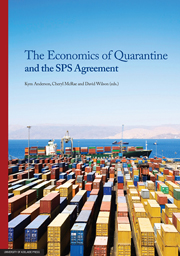Book contents
- Frontmatter
- Contents
- List of tables, figures and boxes
- Acronyms
- Preface
- List of contributors
- 1 Introduction
- PART I The multilateral rules under WTO
- PART II The ‘appropriate level of protection’
- PART III Adding more economics to risk analysis
- 11 Least trade-restrictive SPS policies: an analytic framework is there but questions remain
- 12 Quarantine decision making in Australia
- 13 Quarantine reform: Australia's recent experience
- 14 Evaluating economic consequences of livestock diseases: a US perspective
- PART IV Specific health and environmental risks from trade
- PART V Conclusion
- APPENDIX The legal text of the SPS Agreement
11 - Least trade-restrictive SPS policies: an analytic framework is there but questions remain
from PART III - Adding more economics to risk analysis
Published online by Cambridge University Press: 05 June 2013
- Frontmatter
- Contents
- List of tables, figures and boxes
- Acronyms
- Preface
- List of contributors
- 1 Introduction
- PART I The multilateral rules under WTO
- PART II The ‘appropriate level of protection’
- PART III Adding more economics to risk analysis
- 11 Least trade-restrictive SPS policies: an analytic framework is there but questions remain
- 12 Quarantine decision making in Australia
- 13 Quarantine reform: Australia's recent experience
- 14 Evaluating economic consequences of livestock diseases: a US perspective
- PART IV Specific health and environmental risks from trade
- PART V Conclusion
- APPENDIX The legal text of the SPS Agreement
Summary
This chapter examines the choice among sanitary and phytosanitary policies of those that are least trade-distorting. In addressing this choice, we highlight the potential for complementarity between science-based risk assessment and economic-based cost/benefit analysis in regulatory decision processes. We make the argument for fuller integration of these approaches than is often the case. Integrating risk assessment and cost/benefit analysis simultaneously into the regulatory process provides decision makers with a rich two-dimensional nexus of information. It is too optimistic to expect that for all regulatory decisions a fully optimal policy choice can be achieved when only a single dimension of information is considered. The two-dimensional risk assessment-economic analysis nexus gives decision makers an opportunity to evaluate the trade-offs that are faced when they choose among alternative regulatory measures. The criterion “least trade-restrictive” (or more generally, “least trade-distorting”) is one that policy makers can apply to these decisions. It is not a complete decision-making rule, nor is it the only criterion on which policy options might be ranked, but least trade-restrictive is a criterion mandated by the WTO for consideration in SPS policy determination.
The chapter is organised as follows. The next section provides a brief discussion of the concept of a policy being least trade-distorting. We follow by summarising results from two case studies that were re-analysed using somewhat different approaches than those utilised in regulatory decisions. The possibility for either convergence or divergence between the inferences drawn from risk assessment versus cost/benefit analysis is demonstrated for the case of regulation of avocados entering the United States from Mexico.
- Type
- Chapter
- Information
- The Economics of Quarantine and the SPS Agreement , pp. 183 - 215Publisher: The University of Adelaide PressPrint publication year: 2012



